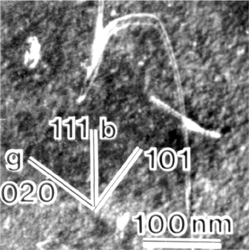 Disdi (now in version 2.24) Disdi (now in version 2.24) See registered users |
The elastic anisotropy of crystalline materials modifies numerous properties of dislocations, for example, the equilibrium configurations or the changes in the interactions between partial dislocations, leading to variations of the dissociation width, and eventually dissociation mode.
The DISDI program is based on Stroh's formalism (1958) and uses a modified version of the ANCALC procedure initially developed by Head, Humble, Clareborough, Morton et Forwood (1973). The program calculates the total energy of a dissociated dislocation and its line tension, find the faults energies from the measured dissociation widths as well as the stability conditions of a dislocation line and the equilibrium shape of a dislocation loop under a constant stress, and for any crystal structure.
Example of a recent publication using DISDI: Size effect, critical resolved shear stress, stacking fault energy, and solid solution strengthening in the CrMnFeCoNi high-entropy alloy, by N. Okamoto et al., Sci. Rep. 6, 35863; doi: 10.1038/srep35863 (2016)
Previously designed for different UNIX platforms, DISDI is now available for Apple Macintosh (OS X) and Windows (9x, 2000, XP).
|
If you want your own copy of DISDI, just click, DISDI is FREE ! |
|
 |
 |
 |
Comparison between the observed shape of a dislocation loop in ß-brass (Micrography by G. Dirras) and the numerical simulation. Notice the very good agreement, especially at the cusp point which corresponds to an instability domain for the dislocation direction. |
Disdi in action (Mac OS X Version) |


